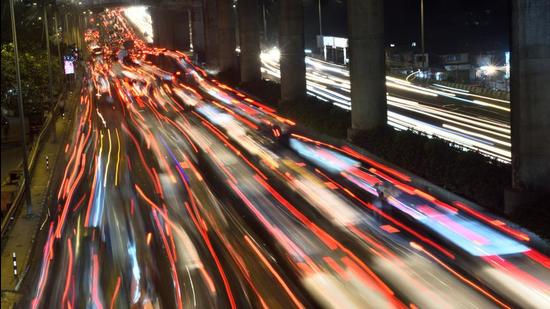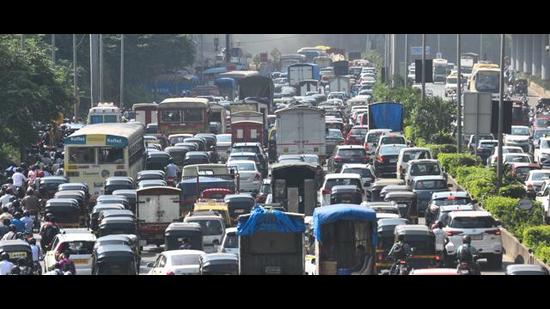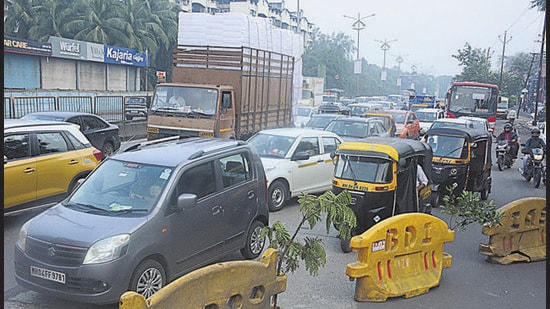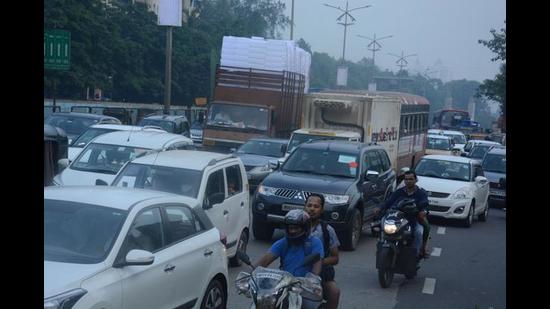North to south Mumbai during peak traffic hours is tiring and tedious
The coastal city of Mumbai is in crisis. There’s plastic in its ocean and its beaches. The fisher communities living along its coastline are losing access to fishing commons and livelihoods. Private vehicles and mass transit systems like buses jostle for space on narrow roads, ensuring longer hours for commuters travelling from North to south Mumbai, making it tiring and tedious. Urban flooding, related to as much to monsoon as to the high tide, is a leading cause of a host of health conditions. In a multi-part series, Hindustan Times asks you to take a clear, hard look at the unfolding crisis and our role in it
In 2016, an Environmental Impact Assessment Report prepared by a consultancy firm at the behest of the Brihanmumbai Municipal Corporation (BMC) included a section based on traffic surveys that were conducted at 17 locations where major highways met nodal arterial roads.

The report was meant to study the feasibility of the coastal road project — an ambitious project that aims to connect south Mumbai to its northern suburb, Kandivli — and found that cars, taxis and jeeps (light fast vehicles) dominated the traffic volume count. At Mumbai Chhatrapati Shivaji Maharaj international airport — one of the locations selected —nearly 68% of the average daily traffic comprised light fast vehicles. According to Vijay Nighot, chief engineer of the Coastal Road Project, “Travel time will reduce by about 70% due to the Coastal Road. The road will also have a dedicated bus route for plying BEST buses with bus stops.”
Opinions on the efficacy of the coastal road to ease the transportation woes is however, divided.
We undertook the journey over four different transportation modes to understand the time it takes for the average Mumbaiite to travel between Kandivli and Nariman Point during the peak hours in the morning and the evening. For those travelling by bus, the journey takes up close to 3.30 to 4 hours; it take a quarter of that time to travel by train, though last mile connectivity is still a pain point. For the biker, traffic snarls at most parts of the journey, including a freeway like the Western Express Highway, meant a long uncomfortable ride of close to two hours. And for those who wish to book a cab over an aggregator service, the woes are compounded as the ride, though long, isn’t financially viable according to many cab drivers.
Since the publication the EIA, the coastal road project has undergone changes. For one, the BMC is now incharge of constructing only one part of it: a 10.58km-long road that will connect Marine Drive to the Worli end of the Bandra-Worli Sea Link. The Maharashtra State Road Development Corporation is incharge of developing the northern half of the coastal road, from Bandra to Kandivli. According to the BMC, 41% of the work — which includes building under-sea tunnels, elevated roads, roads over stilts, bridges and reclaiming land — is over.
Urban planner Rohit Shinkre said, “I recently read statistics that show about 10% of citizens own cars, and about 6% actually use the cars for their daily commute. However, largely the idea of using public transport is associated with discomfort. Now that the Sea Link is in use for so many years, authorities can collate and assess data and actually analyse whether it has helped ease traffic flow, cut fuel cost and cost of commute, and led to decongestion. In my experience, this is not true before you get onto the Sea Link, and once you get off it — those portions are still congested. So the coastal road may ease discomfort of a journey for a partial distance, for a few commuters.”
Experts point out that metros should encourage public transport. How will either scenario — encouraging mass transit or building a coastal road — help the average Mumbaiite? Judging by the commutes we undertook, it’s going to take a lot more to ease travel in the city.

BUS: NINE HOURS ON THE ROAD
Urban developers talk about the need to strengthen mass transit modes like buses for a reason: they’re far more effective in transporting a larger number of people for the space they occupy on a road compared to say, a car.
But travelling in a bus isn’t the most time-efficient experience for the average Mumbaikar. I undertook two peak-hour journeys across Greater Mumbai — from Nariman Point to Kandivali railway station and vice versa —in buses and found that I spent an average of four hours one way. On the whole, I spent nearly nine hours on the road, hoping across five buses.
Let’s start with the return journey.
From the bus stop at Nariman Point’s National Centre for Performing Arts (NCPA), I waited 10 minutes to take the 137 to CST railway station. The bus journey took 30 minutes and stopped seven times. I had to cross the road (taking the underpass) toward the Brihanmumbai Municipal Corporation (BMC) headquarters, in order to catch the 51-C bus to Santacruz bus depot (the central node for BEST buses in the western suburbs).
Most passengers used the bus to make shorter journeys to Nagpada, Byculla, Lalbaug and Dadar. The ride to Santacruz took a little over an hour, making 38 stops. I reached the Santacruz bus depot around 9pm. There, I waited for at least 25 minutes to board route number 202, which goes to Gorai depot over the arterial SV Road and passes through Andheri, Jogeshwari, Goregaon and Malad.
This time, I was fortunate to find a seat. The journey took a little over two hours, and I reached Kandivli railway station after 34 stops at 11.10pm — just 20 minutes short of a five-hour journey. By this time, peak hour traffic had dissipated.
Travelling from Kandivli to Nariman Point in the morning rush hour traffic took 4 hours and 17 minutes. I took the 202 bus from Kandivli station at 9.30am and we crawled along SV Road. I reached Santacruz bus depot an hour and 40 minutes later.
There, I switched to bus number 51-C to CST and encountered traffic jams all the way to Dadar. By 1 pm however, as the bus hit Parel, the rush hour traffic cleared up. The final stretch through Lalbaug, Byculla and Nagpada took a quick 40 minutes, and the 202 bus route from CST to Nariman Point dropped me off at the NCPA bus stop at 1:47 pm exactly.
On average nearly 2.4 million passengers travel daily in the 3500 BEST buses in the city. However, for a suburban resident, a long bus ride to the work district in South Mumbai is certainly not the answer to their transportation needs.
— Prayag Arora Desai

BIKE: UNDER A BLAZING SUN
Two-wheeler journeys in Mumbai’s humidity and blazing sun are strenuous. In addition to the weather, peak hour traffic snarls and constant honking elevate stress levels of riders. Hindustan Times photographer Satish Bate and I set out for this test drive knowing well that it would be a long ride. It was.
We had to travel 39 km but we didn’t have the option to take the Worli Sea-link, as two-wheelers are not allowed on it (the sea link would have cut travel time by several minutes). We left our start point, the Kandivli Station, at 9.30am and hit slow-moving traffic at the very start of the Western Express Highway at Kandivali. At Malad and Jogeshwari, we had to halt for a minute each because of traffic jams. The movement was streamlined as an extra lane was opened from Kandivli onwards on the northbound road for traffic heading south. The journey eased slightly as we crossed Mahim: we were part of a traffic snarl at Tilak Bridge in Dadar and on Pedder Road in south Mumbai. Once we hit the seafront near Wilson College, it was a smooth ride to Nariman Point.
The whole ride took an hour and 56 minutes.
Narrowed space available on the roads due to construction of the coastal road along Marine Drive made the going slow for four-wheelers en route to Babulnath — not so for Satish and I.. This stretch took us merely 16 minutes as we left Maker Chambers at 6.30 pm, the peak hour of evening traffic. Again, at Jaslok hospital, two-wheelers like ours managed to escape the congestion. The longest halt was in south Mumbai near Worli junction where a lone traffic policeman was trying to manage vehicular movement. Within 45 minutes we had reached Mahim, where once more, pedestrian traffic (towards the Dargah) slowed us.Barring the congestion on joining the Western Express highway at Bandra, the traffic was fairly fast moving towards the western suburbs till we reached Jogeshwari.
That’s where the chaos began. Starting at Jogeshwari flyover till we took the turn near the Growel’s Mall in Kandivli, traffic was bumper to bumper. No car had broken down, no barricading justified the jam. The five-km stretch took 35 minutes to negotiate. We reached our end point at 8.40, two hours and 10 minutes later.
The share of light vehicles ranged from 88% at Santacruz flyover to 99% at Worli Dairy. In 2015, there were 1.4 million two-wheelers in Greater Mumbai. By 2017-18, the number had crossed 2 million. Even the pandemic hasn’t slowed down sales. The convenience of negotiating traffic snarls is a significant reason to aid the decision to buy a two-wheeler. But the journey certainly doesn’t justify the purchase.
— Jyoti Shelar and Satish Bate

CAB: A COSTLY, UNCOMFORTABLE RIDE
Would a Mumbaiite chose a bullock-cart for an over 36-km long commute within Mumbai city to go home at the end of a workday? Sitting in a cab, booked on an aggregator application, felt similar. The ride from Maker Chambers in Nariman Point to Kandivli Station took two hours and 20 minutes, with bumper-to-bumper traffic along most of Western Express highway — a freeway with no traffic signals. The average speed we mustered was 16 km/ hour, travelling after 6.30 pm on a workday evening.
Four cab drivers refused the ride which was surprising, because users of cab aggregator services assume that a long ride would be preferable than shorter ones. Turns out, that’s not the case and here’s why. Drivers of aggregate cabs receive a booking via the mobile application, but they can only chose to accept without knowing either destination or fare. For the four who refused to take me to Kandivli, the pre-decided fare was simply not viable for them.
Each time, I cancelled the booking on their request, a surcharge was applied and eventually the last booking cost ₹1,500. A black and yellow taxi would have cost ₹611 for the same distance. Since the fare is not calculated in real-time with a meter for an aggregate cab, most cab drivers of aggregator apps prefer not to take long journeys on busy routes. I switched apps, and booked a ride for ₹746.
The cab driver who agreed to take me to Kandivli only did so on the condition that I would agree to take the Bandra-Worli sea link, where I paid a toll of ₹85. However, barricades along the Worli promenade all the way up to the Sea Link, slowed down traffic considerably. In fact, the journey between Bandra and Kandivli via the Western Expressway — 60% of the distance — took up 75% of the time.
The highway beyond Bandra had bumper to bumper traffic, regardless of traffic signals or bottlenecks. Even flyovers were choked.
Commuting on the same route (starting at Kandivli Station) in the morning peak hour — we left Kandivli at 9.30 am — was equally tedious, but less time consuming. In the morning, the Western Express highway up till Bandra was less congested. However, traffic was considerably denser on Marine Drive and around Mantralaya. It took longer to cross the sea face at Haji Ali, and Pedder Road, in comparison to the time it took during the evening peak hour.
Luckily, the first cab that I booked agreed to the commute. The journey was completed in one hour and 52 minutes, and cost ₹642.
On the whole, the commute is basically unaffordable for any salaried middle class person.
— Eeshanpriya MS
TRAIN: FASTEST RIDE IN TOWN
For the average Mumbaiite, train journeys are the most reliable form of mass transit and are inexpensive — a monthly pass costs a few hundred rupees depending on the destinations — but when it comes to peak hours, it’s always a gamble. Is it better to hop on to a slow train or wait for a fast one? Will the next train have space to accommodate you? In case one lands up in a slow train, does it save time to board a fast train eventually to travel a longer route? And, in the midst of a pandemic, is it safe?
The Western Railway transports at least 3.5 million passengers a day — since the pandemic started and the government put restrictions on who can travel by train (only those who are doubly vaccinated, even if they are essential workers), the numbers have fallen.
Even so, delays are built in to this mode of transport, as many passengers switch between slow and fast trains at different platforms. In the pandemic, in an effort to prevent crowding at ticket counters, the railway has permitted only monthly passes for double-vaccinated people.
For this test drive, I reached Kandivli station at 9.33 am on a Thursday. I had missed a fast train to Churchgate by four minutes and the next train to arrive was a 9.36 slow local for Andheri. I boarded the train that came after that in the hope that it would be less crowded, taking instead the 9.40am Churchgate-bound slow train. Waiting for the next fast train would have meant spending another 13 minutes at the station.
Many daily commuters who board trains from slow destinations like Kandivli, Malad or Goregaon prefer switching to a fast train from Andheri to save time. By the time we reached Andheri, it was 10.05 am. Alighting from this train, I walked to another platform to board the 10.12 fast train to Churchgate — it was far more crowded than the slow train I had left. Not everyone had their mask on — many had it pulled under their chin. It took exactly 10 minutes to reach the next station, Bandra, and another seven minutes to reach Dadar. By 10.45 am, I had reached Churchgate.
Taxis or buses are the only options for last mile connectivity from the station to Maker Chambers in Nariman Point. Most commuters opt for a shared cab. I did too. The one I sat in left the station at 10.49 am and I reached Maker Chambers at 10.55 am. The six-minute-long ride cost ₹15.
The evening journey back to Kandivli was faster because of the fast train available from Churchgate. The train was packed. A slow train would have taken about 20 minutes longer than a fast train but it would likely have been less crowded.
— Jyoti Shelar



